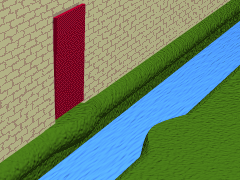Drawbridge
Drawbridge
A drawbridge is a type of movable bridge typically associated with the entrance of a castle, fortification, or tower. Its primary function is to allow or prevent access across a moat or ditch, but it has also been used in many other contexts, including as a means of controlling access to fortified towns, river crossings, and even modern-day properties for aesthetic or security reasons.
History[edit | edit source]
The drawbridge is an ancient invention, with its origins tracing back to medieval Europe during the early Middle Ages. It was a critical component of medieval architecture, especially in the design of castles. The drawbridge was often used in conjunction with a portcullis to provide a formidable defense. It allowed inhabitants to defend the entrance of the castle effectively by raising the bridge against attackers, thereby cutting off access via the moat which surrounded the structure.
Mechanism[edit | edit source]
The traditional drawbridge operates on a simple principle: it pivots and can be raised or lowered. Early drawbridges were manually operated using ropes or chains wound around a winch. The other end of the bridge was often weighted, making it easier to raise. In more sophisticated designs, a counterweight was used to balance the bridge, known as a bascule bridge. This design reduced the force required to lift the bridge and allowed for larger bridges to be constructed.
Types[edit | edit source]
There are several types of drawbridges, including:
- Bascule Bridge: A bridge with a counterweight that continuously balances a span, or "leaf," throughout its upward swing to provide clearance for boat traffic.
- Lifting Bridge: A bridge that lifts straight up on vertical guides, often powered by hydraulics.
- Swing Bridge: A bridge that rotates around a central pivot to allow passage.
Modern Usage[edit | edit source]
While drawbridges are often associated with medieval fortifications, they continue to be used in modern infrastructure, particularly in the design of bridges to allow the passage of boats in navigable waters. Modern drawbridges, such as bascule bridges and lifting bridges, are commonly found in many parts of the world, serving both practical and aesthetic purposes.
Cultural Significance[edit | edit source]
The drawbridge has a significant place in folklore, symbolizing the threshold between safety and danger, the known and the unknown. It appears in many stories and fairy tales, often as a barrier that must be crossed or as a means of protection.
Preservation[edit | edit source]
Many historical castles with drawbridges are preserved as tourist attractions, museums, or heritage sites. These structures offer a glimpse into the past and are valuable for educational and cultural preservation efforts.
This article is a architecture-related stub. You can help WikiMD by expanding it!
Search WikiMD
Ad.Tired of being Overweight? Try W8MD's physician weight loss program.
Semaglutide (Ozempic / Wegovy and Tirzepatide (Mounjaro / Zepbound) available.
Advertise on WikiMD
|
WikiMD's Wellness Encyclopedia |
| Let Food Be Thy Medicine Medicine Thy Food - Hippocrates |
Translate this page: - East Asian
中文,
日本,
한국어,
South Asian
हिन्दी,
தமிழ்,
తెలుగు,
Urdu,
ಕನ್ನಡ,
Southeast Asian
Indonesian,
Vietnamese,
Thai,
မြန်မာဘာသာ,
বাংলা
European
español,
Deutsch,
français,
Greek,
português do Brasil,
polski,
română,
русский,
Nederlands,
norsk,
svenska,
suomi,
Italian
Middle Eastern & African
عربى,
Turkish,
Persian,
Hebrew,
Afrikaans,
isiZulu,
Kiswahili,
Other
Bulgarian,
Hungarian,
Czech,
Swedish,
മലയാളം,
मराठी,
ਪੰਜਾਬੀ,
ગુજરાતી,
Portuguese,
Ukrainian
Medical Disclaimer: WikiMD is not a substitute for professional medical advice. The information on WikiMD is provided as an information resource only, may be incorrect, outdated or misleading, and is not to be used or relied on for any diagnostic or treatment purposes. Please consult your health care provider before making any healthcare decisions or for guidance about a specific medical condition. WikiMD expressly disclaims responsibility, and shall have no liability, for any damages, loss, injury, or liability whatsoever suffered as a result of your reliance on the information contained in this site. By visiting this site you agree to the foregoing terms and conditions, which may from time to time be changed or supplemented by WikiMD. If you do not agree to the foregoing terms and conditions, you should not enter or use this site. See full disclaimer.
Credits:Most images are courtesy of Wikimedia commons, and templates, categories Wikipedia, licensed under CC BY SA or similar.
Contributors: Prab R. Tumpati, MD



